 |
|

|
 |
TABLE of CONTENTS
 |
New roundabout under construction to improve safety in District 1 |
By Margie Nelson, District 1 public affairs coordinator
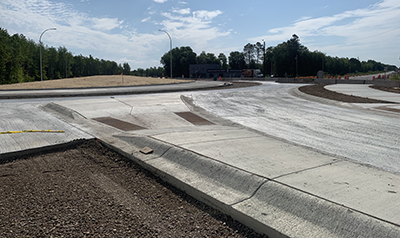
The new roundabout on Hwy 2 in District 1. Photo by Margie Nelson |
District 1’s seventh roundabout is under construction at the intersection of Hwy 2 and Hwy 194 in Saginaw, with work expected to be completed in October.
This section of Hwy 2, just outside Hermantown, sees an average of about 5,600 cars per day. The intersection has had a high level of crashes due to the angle of Hwy 2 entering Hwy 194, which prompted MnDOT to select it for improvements.
In January 2019, a consultant firm looked at seven options in the intersection control evaluation before coming to the final alternatives of single-lane roundabout, all-way stop or rural intersection conflict warning system. Two of those options would still not eliminate the potential for right angle crashes, so a roundabout was determined to be the preferred alternative. St. Louis County is sharing in the cost with MnDOT, as Cty Rd 46 makes up one of the legs. Additionally, the project has received nearly $1.7 million in federal safety funds due to the high crash rate.
“The crash rate was over three times the state average and severity rate over two times state average,” Project Manager Tom Lamb said. “While there were some safety improvements like flashing lights at the stop signs installed previously, these improvements had limited success in addressing the crash issues. This roundabout will significantly improve the overall safety of this intersection.”
This project also includes resurfacing almost three miles of Hwy 2, repaving the ramps entering Hwy 33 from Hwy 2, and lining and repairing culverts. Ulland Brothers of Cloquet is the general contractor. Constructing staging required a detour on county roads to construct a bypass at the start of the project, and the detour will also be used at the end of the project for completion of the roundabout. The project also necessitated use of single-lane traffic controlled by a signal during work on the guardrails and culvert under a Canadian National railroad bridge. Work is expected to be completed in October. |
| |
|

|
 |
TABLE of CONTENTS
 |
MnDOT employees battle Canada wildfire as part of DNR program |
By Joseph Palmersheim
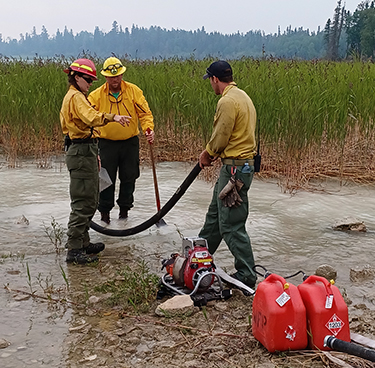
Anthony Murilla, middle, helps set up a pump for a hose lay while fighting wildfires in Canada as part of a MnDOT-DNR agreement to provide firefighters for wildfire emergency services elsewhere.
Submitted photo
|
While many Minnesotans could smell the smoke from Canadian wildfires this summer, two MnDOT employees got much closer than that.
Nate Johnson, a prescribed fire coordinator based at Central Office, and Anthony “Tony” Murilla, District 6 prescribed burn coordinator, were among many firefighters from other places fighting the WE 027 fire in Manitoba.
As part of its Prescribed Fire Program, MnDOT has staff qualified to help the Department of Natural Resources fight wildfires. Both agencies have a master partnership agreement where, in emergencies, the DNR can call on MnDOT staff to help. These employees get paid through the DNR while performing wildland firefighting work.
Johnson and Murilla were gone from July 8 to July 26, with two days travel time on each end of their two-week assignment fighting the fire. The fire had consumed 22,000 acres of land when they arrived and had grown to 54,000 acres by the time they left.
Nate Johnson was on the north side of the fire. While he’d fought smaller fires in Minnesota and California, it was his first time in Canada.
“We were on the first site for six days and after that we were flown by helicopter to other spots,” he said. “Every day was a little different. We’d be up around 6:30 and have breakfast. It was remote camping with no cell service. We had small propane stoves, coolers and boxes of food. We were typically on the fire line by 8 a.m., and back to camp at 8 p.m., sometimes later. We had a lake I jumped into every night.”
Johnson, a five-year MnDOT employee, got started with prescribed burns while working for the DNR in 1998. Back then, he was a summer intern.
“When I found out I could play with fire and get paid for it, I switched my career goals and chose this instead of a business career,” he said. “I also work with the Spicer Fire Department. I’m either lighting fires or putting them out, one of the two.”
Anthony Murilla was on the north side of the fire, too, and spent his entire assignment on the same spot. He’d fought fires in northern Minnesota in 2021, and small fires around Minnesota. In Canada, his crew anchored in at the side of a lake and would make their way in one to two feet at a time.
“I was very impressed with the Canadians,” he said. “They are tough, tough people. The work that they put their firefighters through is amazing. Some of them are doing this all summer long, with 24 days on 4 off. They are right back out there working hard.”
The 12-year MnDOT employee started on structural firefighters with the La Crescent Fire Department in 2011.
“My grandfather, uncle and dad did this, and it was always something I've wanted to do, too,” he said. “I started with La Crescent after I got out of the U.S. Army in 2011. I got into the Prescribed Burn Program in District 6 about five years later. I enjoy doing it – being outside and working hard.” |
| |
|

|
 |
TABLE of CONTENTS
 |
Dr. Debra Lindh named new organizational health consultant |

|
Dr. Debra Lindh has joined MnDOT’s Office of Human Resources as the agency’s organizational health consultant, effective July 24. Lindh fills a position that had existed previously but had recently been vacant.
“We brought this position back because it seems like an opportune time to focus on overall employee wellbeing given the impacts of COVID,” said Bonnie Wohlberg, MnDOT’s acting HR director. “Managers, supervisors and employees across the agency had also expressed a specific need for more improved organizational health consultation.”
Lindh has more than 20 years of experience in operations management and applied social science research. Twelve of those years include experience in organizational development aligning organizational systems, people engagement and development and evidence-based research. She has experience as a graduate level professor and mental health first aid provider. Lindh has a Bachelor of Science in organizational communication, a Master of Arts in organizational leadership and a Doctor of Education in organization development.
“Organizational health is a vital purpose to all employees, the folks we serve and the greater good for society,” said Lindh. “I look forward to collaborating across MnDOT being a strategic resource providing evaluation, support and programs instrumental for holistic effectiveness as well as building sustainable shared systems that strengthen organizational heath for individuals, teams, departments, and throughout the agency.”
|
| |
|

|
 |
TABLE of CONTENTS
|
MnDOT STEM ambassadors teach students about transportation careers |
By Marcia Lochner, STEM Education and Outreach Program Manager
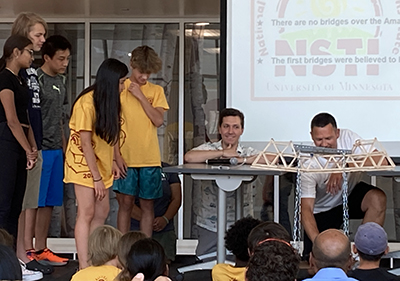
MnDOT Bridge engineer Nolan Bach observes as the first-place team’s bridge strains to support 20 pounds. Photo by Su Love
|
Ambassadors from MnDOT’s Bridge Office, MnROAD and Surveys led multiple educational sessions for 30 middle school students attending the University of Minnesota Center for Transportation Studies National Summer Transportation Institute in July.
NSTI is a two-week youth camp hosted by CTS, with funding from the Federal Highway Administration and administered by the MnDOT Office of Civil Rights. “I enjoy reading the applications,” said Orlanda Klinkhammer, one of the Civil Rights employees involved in the selection committee. “Each one is unique and the students have great ideas for the future.”
The annual two-week summer camp lets students explore careers and education opportunities related to science, engineering and transportation in a hands-on environment. In addition to sessions led by other industry partners, students learned about MnDOT’s road materials and research, land surveying technologies and bridge engineering. MnDOT staff paired these subjects with hands-on activities where students made asphalt (chocolate) cookies, tried out the augmented reality sandbox and surveying equipment, and designed/built their own model bridges that they tested during the closing ceremony on the last day of camp, July 28.
|
|

|
 |
TABLE of CONTENTS
 |
New financial reporting system in the works |
By Susan Walto, financial operations manager, Office of Financial Management
The Office of Financial Management, along with MNIT partners, has kicked off a new program branded MARCUS, or Modernizing Accounting, Reporting and Consumption Unified Systems.
As the name implies, OFM is looking to modernize how MnDOT approaches accounting and finances. The program includes a three-pronged approach:
- Transition from RCA to Self Service for time entry and, possibly, business expenses.
- Identify the best approach to cost accounting.
- Modernize applicable systems.
MnDOT has used RCA for about 25 years, after some MnDOT employees developed it as an application to track time, equipment usage and material usage. Its scope later grew to include, accomplishments, mile posts, work orders, pesticide application licensing and business expenses. With time and technology changes, MnDOT has determined that the timesheet functions in RCA can be transitioned to Self Service. The other functions will be reviewed to determine where they belong or if they can be retired.
MnDOT’s CFO, Josh Knatterud-Hubinger, is the executive sponsor for the program while the owners are Controller/OFM Office Director Robin Sylvester, in partnership with Beth Guidarelli, Financial Systems Manager with MNIT. In kicking off MARCUS, Knatterud-Hubinger stated, “Our guiding principles are to ensure our solutions are accurate, fair and simple without losing integrity and transparency.”
The MARCUS owners and project managers have gathered a number of people to start providing input and researching the impacts of such a large change for MnDOT. Although parts of the program will be implemented like a project, much of it will continue as a new way of doing business.
The process is expected to take some time, and employees will probably not switch to entering time in Self Service until July 2025 at the earliest. Until then, find updates and more information on the MARCUS iHUB page.
|
| |
|

|
 |
TABLE of CONTENTS
 |
Bridge Office marks 10 years of innovative coating process |
By Mark Spafford, Bridge Office
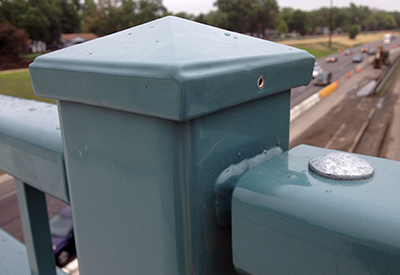
An example of the new coating. Photo by Mark Spafford
|
What do you get when you combine a metallurgically bonded galvanized coating with a super-durable powder coating? Answer: A lower cost, environmentally friendly, steel ornamental metal railing that will outlive most of us.
This type of treatment is known as “duplex coating” and the Bridge Office recently marked the tenth year of using it, after a successful pilot project in July 2013, when MnDOT first installed a duplex-coated ornamental metal railing on the east side of the Xerxes Avenue bridge over I-494 just south of Minneapolis. It was the first project of its kind in the state and used a process that the Bridge Office had worked with paint manufacturers to perfect specifically for Minnesota.
In the beginning, approved fabricators and applicators resisted the new process, but they quickly realized the cost benefit due to improved durability. It has proven to be effective technique and a decade after its introduction, this method of placing a powder coating over an initial zinc layer has become a successful standard finish for Bridge Office railings.
Duplex coating involves a two-step process. In the first step, the freshly cleaned steel railing is submerged into a kettle of 850-degree molten zinc. The zinc bonds with the steel in a diffusion reaction. The zinc layer provides cathodic and barrier protection, which prevents the steel from oxidizing. The second coating application consists of two electrostatically applied coats of a baked-on powder coating. The baked-on powder is literally cured within the time it takes to cool a 400-degree component, much faster than the days required when using liquid paint.
The synergistic effect of using two coatings extends the service life for unparalleled corrosion protection, which is especially important in the extreme climate of the Midwest. When powder coating and galvanized steel are used together, the corrosion protection is superior to either protection system used alone and can last up to two and a half times the combined lifetimes of both systems.
Since that pilot project 10 years ago, the duplex coating utilizing powder coating has become standard for Bridge Office projects across the state, and word has spread beyond the agency. Other states and Minnesota cities and counties have adopted it, and other states have, too, often seeking out information and best practices from the Bridge Office for their own projects. |
| |
|

|
 |
TABLE of CONTENTS
 |
iHUB user survey offers opportunity for employee feedback |

The Office of Communications and Public Engagement is looking for employee feedback on ways to improve iHUB.
|
iHUB is an essential resource for MnDOT employees, a place to find news, contacts, essential details about agency offices and much more.
To ensure that it remains a useful tool for employees, the Office of Communications and Public Engagement is seeking feedback on how iHUB is working and any concerns or suggestions.
Please help by completing the iHUB user survey. It’s short – just eight questions! – but will provide the web team with essential information as it works to update and improve iHUB.
|
| |
|

|
 |
TABLE of CONTENTS
|
On the Job: Joel Wenz and Clay Ebeling produce compelling visual narratives |
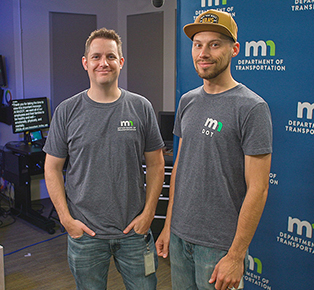
Joel Wenz and Clay Ebeling. Photo by Carol Hennekens
|
By Doug Mack
Back in 1977, when MnDOT’s Video and Audiovisual Services unit began, there were reel and VHS tapes. Technology has changed significantly since then, and Video and AV Services has changed with it, continuing to provide expert video production services and AV support across the agency.
The team provides five main services to MnDOT employees: video production, from planning and script development to filming and editing; AV support for conferences and events; livestreaming; equipment check-out; and video uploading, copying, and transferring. This supports everything from safety to program delivery to public service.
Video and AV Services consists of two experts: Joel Wenz and Clay Ebeling.
How long have you been at MnDOT?
Joel: 13 years.
Clay: 11 years.
What the most challenging and rewarding parts of your job?
Joel: It can be a challenge at times to create compelling visual narratives that communicate complex government initiatives effectively. Balancing the need for accuracy with creative storytelling can be demanding, requiring meticulous research and a keen eye for detail. However, the reward lies in the potential impact of our work.
Clay: With 15-plus years of experience in video production, the most challenging part of my job is recognizing limitations of what we can offer to clients and my own limitations of what I know how to do. It's easy to say "yes" to all requests, but I never want to fail someone. Knowing what the client is asking for and what we can offer with a high certainty of success is so rewarding when all goes well. It's hard to think of ways something could fail and how to plan for the worst. Doing so reliably is the best part of my job.
How has your job changed since your first started?
Joel: The evolution of camera equipment has elevated the quality of our visuals significantly. Editing processes have become more efficient, allowing for quicker turnaround and increased creativity.
Clay: In many ways! I was a kid when I started, now I'm soon to be a dad of my third son. The equipment we use has gotten smaller, more affordable, easier to use and somehow higher quality. It's crazy that our team has gotten smaller, but we offer more services than ever before.
Is there anything about your job that might surprise other people (either inside or outside MnDOT)?
Joel: Within the agency many may not realize our small team functions as a versatile one-stop shop, equipped to handle various aspects of video production in-house. From simple video conversions to complex productions, our team’s ability to manage the entire production process can come as a surprise to colleagues who might have traditionally sought external assistance.
Clay: Internally we can make high quality videos for nearly, and most often, no cost to MnDOT. When contracting a vendor to do the same work could cost tens of thousands. Externally the public might not know our two-person team can do a multi-camera live broadcast from under a bridge.
What are your interests or hobbies outside your work with MnDOT?
Clay: I love to read and learn about things I don't understand. Mostly science and mental/physical health, with a dash of fiction and history mixed in. I love and hate that my wish list grows faster than I can read. I also love to play board games with my family and friends. Lastly, I really enjoy teaching my oldest how to ride OneWheel (PPE included). Surprisingly, a 25-pound hunk of tech has helped me a lot on my mental health journey and made me feel more connected to nature. Sharing that with my son is fun to watch.
To learn more or request a service, visit the Video and AV Services page on iHUB. You will receive a response to your request within 48 hours. Questions and comments can be sent to Joel Wenz, Clay Ebeling or Carol Hennekens.
Do you or a co-worker have an interesting job to share with readers? Send us your ideas, and we’ll contact you for more information.
Recent employee profiles:
|
 |
|

|
 |
TABLE of CONTENTS
|
New signs mark a highway for a music legend |
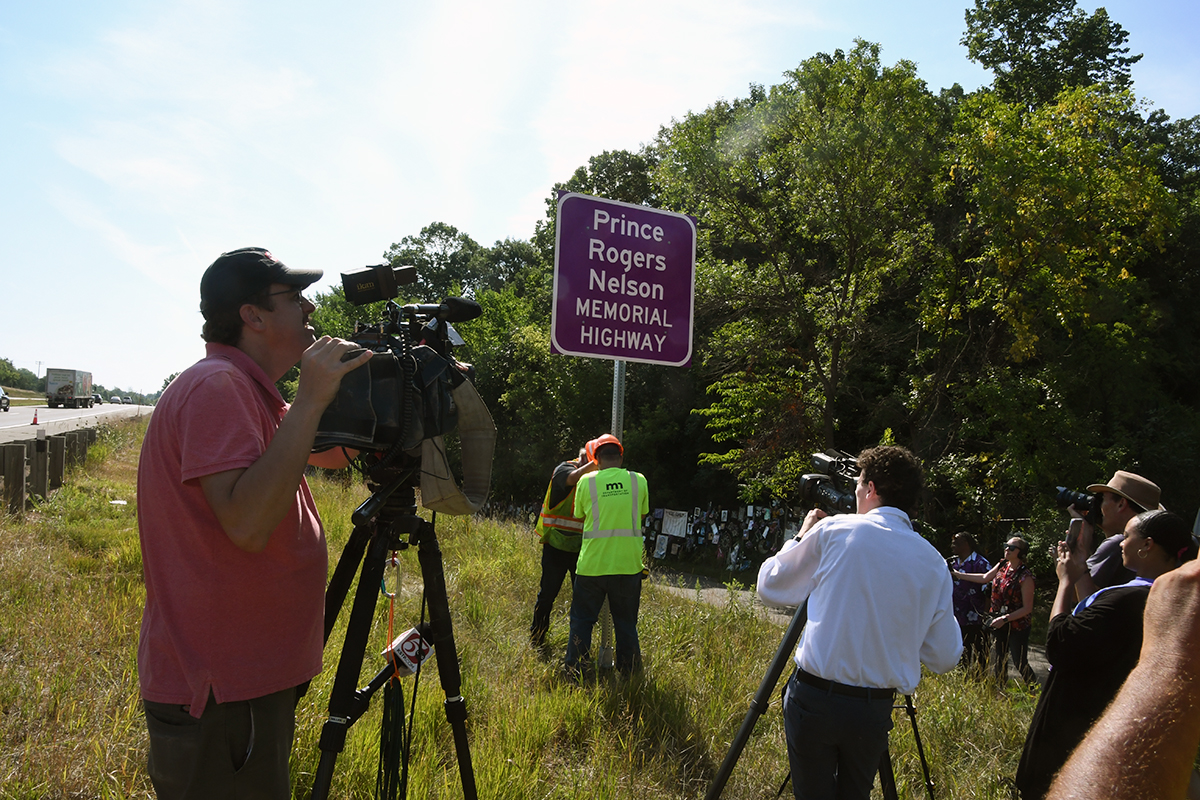
New Prince Rogers Nelson Memorial Highway sign. Photo by Mark Olson
|
By Doug Mack
There was no purple rain on Aug. 3, but the spirit of Minnesota’s biggest rock star was present as MnDOT crews put up signs marking a seven-mile stretch as Prince Rogers Nelson Memorial Highway.
The designation had been approved by the state legislature and signed into law by Gov. Tim Walz in May. A few of the key legislators were present for the installation, along with friends and family of Prince.
The signs were allowed to be a distinctive purple color – of course – and were privately funded by a group led by Paisley Park employee Mark Webster.
|
 |
|

|
 |
TABLE of CONTENTS
|
Name That Place Puzzler #6 |
By Doug Mack
Can you name the place pictured below? The photo is from MnDOT staff and the satellite image is from the 511 website and app. This one is tricky, but keep at it and don’t get blue if you’re feeling like a mound of confusion.
If you think you know the answer, email Newsline editor Doug Mack. The first three people to submit the correct answer will receive the fame and glory of having their names listed in the next issue of Newsline.
Results from the last Puzzler: The gravel portion of Hwy 74 near Whitewater State Park in District 6, which is the last stretch of unpaved state highway in Minnesota. More than 50 people submitted answers and nearly all of them were correct. The first three to get it right were Anthony Bale (District 6), Micah Holzbauer (Materials and Road Research) and Chris Moates (Central Office). Congrats to them and thanks to everyone who played!
|
 |
|
|
|



